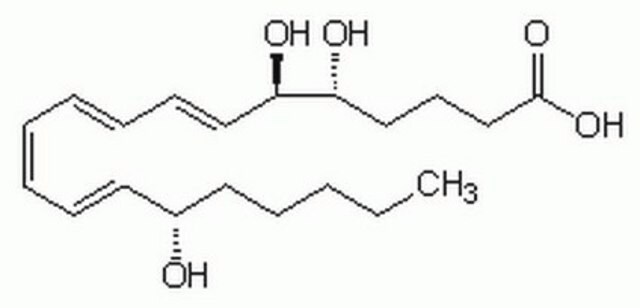H7768
12(S)-Hydroxy-(5Z,8Z,10E,14Z)-eicosatetraenoic acid
~100 μg/mL in ethanol, ≥95% (HPLC)
Synonyme(s) :
(S)-12-HETE
About This Item
Produits recommandés
Niveau de qualité
Pureté
≥95% (HPLC)
Forme
liquid
Concentration
~100 μg/mL in ethanol
Conditions d'expédition
dry ice
Température de stockage
−20°C
Chaîne SMILES
CCCCC\C=C/C[C@H](O)\C=C\C=C/C\C=C/CCCC(O)=O
InChI
1S/C20H32O3/c1-2-3-4-5-10-13-16-19(21)17-14-11-8-6-7-9-12-15-18-20(22)23/h7-11,13-14,17,19,21H,2-6,12,15-16,18H2,1H3,(H,22,23)/b9-7-,11-8-,13-10-,17-14+/t19-/m0/s1
Clé InChI
ZNHVWPKMFKADKW-LQWMCKPYSA-N
Vous recherchez des produits similaires ? Visite Guide de comparaison des produits
Actions biochimiques/physiologiques
Conditionnement
Mention d'avertissement
Danger
Mentions de danger
Conseils de prudence
Classification des risques
Eye Irrit. 2 - Flam. Liq. 2
Code de la classe de stockage
3 - Flammable liquids
Classe de danger pour l'eau (WGK)
WGK 1
Point d'éclair (°F)
55.4 °F
Point d'éclair (°C)
13 °C
Certificats d'analyse (COA)
Recherchez un Certificats d'analyse (COA) en saisissant le numéro de lot du produit. Les numéros de lot figurent sur l'étiquette du produit après les mots "Lot" ou "Batch".
Déjà en possession de ce produit ?
Retrouvez la documentation relative aux produits que vous avez récemment achetés dans la Bibliothèque de documents.
Notre équipe de scientifiques dispose d'une expérience dans tous les secteurs de la recherche, notamment en sciences de la vie, science des matériaux, synthèse chimique, chromatographie, analyse et dans de nombreux autres domaines..
Contacter notre Service technique









